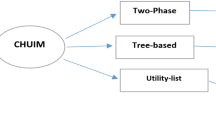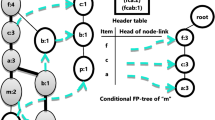Abstract
Constraint Programming is a powerful paradigm to model and solve combinatorial problems. While there are many kinds of constraints, the table constraint is perhaps the most significant—being the most well-studied and has the ability to encode any other constraints defined on finite variables. However, constraints can be very voluminous and their size can grow exponentially with their arity. To reduce space and the time complexity, researchers have focused on various forms of compression. In this paper, we propose a new approach based on maximal frequent itemsets technique and area measure for enumerating the maximal frequent itemsets relevant for compressing table constraints. Our experimental results show the effectiveness and efficiency of this approach on compression and on solving compressed constraint satisfaction problem.




Similar content being viewed by others
Data availability
The Oscar solver is available at https://bitbucket.org/oscarlib/oscar/src/dev/. The Instances used in our experiments to validate the approach can be found at: https://bitbucket.org/pschaus/xp-table/src/master/instances/. The source code of our implementation is available at https://bitbucket.org/pschaus/xp-table/src/master/instances/.
Notes
The area of an itemset is the product of its length and its frequency value.
benchmarks downloaded from https://bitbucket.org/pschaus/xp-table/src/master/instances/.
For an itemset u \(\in\) \({{{\mathcal {L}}}}_{{\mathcal {I}}}\) and a transaction t, \(match(p,t) = true iff p\) covers the transaction t.
References
Pesant G (2004) A regular language membership constraint for finite sequences of variables. In: International Conference on Principles and Practice of Constraint Programming. Springer, Berlin, pp 482–495
Cheng KCK, Yap RHC (2010) An MDD-based generalized arc consistency algorithm for positive and negative table constraints and some global constraints. Constraints 15(2):265–304
Mohr R, Masini G (1988) Good old discrete relaxation. In: 8th European Conference on Artificial Intelligence (ECAI ’88), Munich, pp 651–656
Bessiere C, Régin J-C (1997) Arc consistency for general constraint networks: preliminary results. In: IJCAI-97. Nagoya, Japan, pp 398–404
Yap RHC, Xia W, Wang R (2020) Generalized arc consistency algorithms for table constraints: a summary of algorithmic ideas. In: Proceedings of the AAAI Conference on Artificial Intelligence, pp 13590–13597
Bessiere C, Régin J-C, Yap RHC et al (2005) An optimal coarse-grained arc consistency algorithm. Artif Intell 165(2):165–185
Wang R, Xia W, Yap RHC et al (2016) Optimizing simple tabular reduction with a bitwise representation. In: IJCAI, pp 787.v–795.v
Verhaeghe H, Lecoutre C, Schaus P (2017) Extending compact-table to negative and short tables. In: Thirty-First AAAI Conference on Artificial Intelligence
Ullmann JR (2007) Partition search for non-binary constraint satisfaction. Inf Sci 177(18):3639–3678
Lecoutre C (2011) STR2: optimized simple tabular reduction for table constraints. Constraints 16(4):341–371
Lecoutre C, Likitvivatanavong C, Yap RHC (2015) STR3: a path-optimal filtering algorithm for table constraints. Artif Intell 220:1–27
Mairy J-B, Deville Y, Lecoutre C (2015) The smart table constraint. In: International Conference on Integration of Constraint Programming, Artificial Intelligence, and Operations Research. Springer, Cham, pp 271–287
Audemard G, Lecoutre C, Maamar M (2020) Segmented tables: an efficient modeling tool for constraint reasoning. In: ECAI 2020. IOS Press, pp 315–322
Katsirelos G, Walsh T (2007) A compression algorithm for large arity extensional constraints. In: International Conference on Principles and Practice of Constraint Programming. Springer, Berlin, pp 379–393
Xia W, Yap RHC (2013) Optimizing STR algorithms with tuple compression. In: International Conference on Principles and Practice of Constraint Programming. Springer, Berlin, pp 724–732
Jefferson C, Nightingale P (2013) Extending simple tabular reduction with short supports. In: Twenty-Third International Joint Conference on Artificial Intelligence
Gharbi N, Hemery F, Lecoutre C et al (2014) Sliced table constraints: combining compression and tabular reduction. In: International Conference on Integration of Constraint Programming, Artificial Intelligence, and Operations Research. Springer, Cham, pp 120–135
Mairy J-B, Deville Y, Lecoutre C (2015) The smart table constraint. In: International Conference on Integration of Constraint Programming, Artificial Intelligence, and Operations Research. Springer, Cham, pp 271–287
Verhaeghe H, Lecoutre C, Deville Y et al (2017) Extending compact-table to basic smart tables. In: International Conference on Principles and Practice of Constraint Programming. Springer, Cham, pp 297–307
Jabbour S, Roussel S, Sais L et al (2015) Mining to compress table constraints. In: 2015 IEEE 27th International Conference on Tools with Artificial Intelligence (ICTAI). IEEE, pp 405–412
Bennai S, Amroun K, Loudni S (2019) Exploiting data mining techniques for compressing table constraints. In: 2019 IEEE 31st International Conference on Tools with Artificial Intelligence (ICTAI). IEEE, pp 42–49
Montanari U (1974) Networks of constraints: fundamental properties and applications to picture processing. Inf Sci 7:95–132
Guns T, Nijssen S, De Raedt L (2011) Itemset mining: a constraint programming perspective. Artif Intell 175(12–13):1951–1983
Han J, Pei J, Yin Y (2000) Mining frequent patterns without candidate generation. ACM Sigmod Rec 29(2):1–12
Maamar M, Lazaar N, Loudni S et al (2017) Fault localization using itemset mining under constraints. Autom Softw Eng 24(2):341–368
Pasquier N, Bastide Y, Taouil R et al (1999) Discovering frequent closed itemsets for association rules. In: International Conference on Database Theory. Springer, Berlin, pp 398–416
Boulicaut J-F, Artur B,Christophe R (2000) Approximation of frequency queries by means of free-sets. In: European Conference on Principles of Data Mining and Knowledge Discovery. Springer, Berlin
Bayardo Jr. RJ (1998) Efficiently mining long patterns from databases. In: Proceedings of the 1998 ACM SIGMOD International Conference on Management of Data
Mannila H, Toivonen H (1997) Levelwise search and borders of theories in knowledge discovery. Data Min Knowl Discov 1(3):241–258
Pasquier N, Bastide Y, Taouil R et al (1999) Efficient mining of association rules using closed itemset lattices. Inf Syst 24(1):25–46
Ke Y, Cheng J, Yu JX (2009) Top-k correlative graph mining. In: Proceedings of the 2009 SIAM International Conference on Data Mining. Society for Industrial and Applied Mathematics, pp 1038–1049
Wang J, Han J, Lu Y et al (2005) TFP: an efficient algorithm for mining top-k frequent closed itemsets. IEEE Trans Knowl Data Eng 17(5):652–663
Uno T, Kiyomi M, Arimura H et al (2004) LCM ver. 2: Efficient mining algorithms for frequent/closed/maximal itemsets. In: FIMI
Perez G, Régin J-C (2014) Improving GAC-4 for table and MDD constraints. In: International Conference on Principles and Practice of Constraint Programming. Springer, Cham, pp 606–621
Verhaeghe H, Lecoutre C, Schaus P (2018) Compact-MDD: efficiently filtering (s)MDD constraints with reversible sparse bitsets. In: Proceedings of the 27th International Joint Conference on Artificial Intelligence
Verhaeghe H, Lecoutre C, Deville Y, Schaus P (2017) Extending compact-table to basic smart tables. In: Proceedings of the 23rd International Conference on Principles and Practice of Constraint Programming
Verhaeghe H, Lecoutre C, Schaus P (2017) Extending compact-table to negative and short table. In: Proceedings of the 31st AAAI Conference on Artificial Intelligence, pp 3951–3957
Wang R, Yap RH (2019) Arc consistency revisited. In: Proceedings of the 16th International Conference on the Integration of Constraint Programming, Artificial Intelligence, and Operations Research. Springer, pp 599–615
Geerts F, Goethals B, Mielikäinen T (2004) Tiling databases. In: Suzuki E, Arikawa S (eds) Discovery Science. DS 2004. Lecture Notes in Computer Science, vol 3245. Springer, Berlin. https://doi.org/10.1007/978-3-540-30214-8_22
Fleischer R (1994) A tight lower bound for the worst case of bottom–up-heapsort. Algorithmica 11(2):104–115
Acknowledgements
This work has been sponsored by the General Directorate for Scientific Research and Technological Development, Ministry of Higher Education and Scientific Research DGRSDT, Algeria.
Author information
Authors and Affiliations
Corresponding authors
Additional information
Publisher's Note
Springer Nature remains neutral with regard to jurisdictional claims in published maps and institutional affiliations.
Rights and permissions
About this article
Cite this article
Bennai, S., Amroun, K., Loudni, S. et al. An efficient heuristic approach combining maximal itemsets and area measure for compressing voluminous table constraints. J Supercomput 79, 650–676 (2023). https://doi.org/10.1007/s11227-022-04667-1
Accepted:
Published:
Issue Date:
DOI: https://doi.org/10.1007/s11227-022-04667-1




